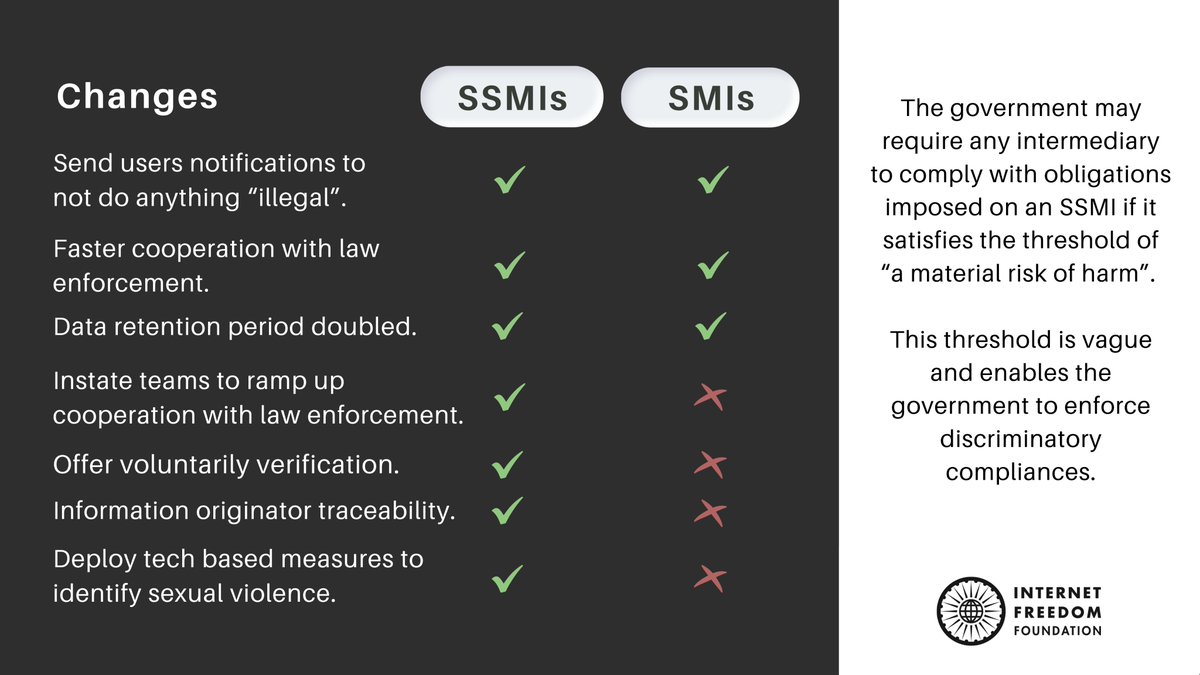
🚨 Breaking: We are releasing a copy of the Draft IT (Intermediary Guidelines and Digital Media Ethics Code) Rules, 2021, which seek to change the face of how digital media is governed in India.
Read our thread and analysis of the biggest concerns.
1/n
internetfreedom.in/latest-draft-i…
Read our thread and analysis of the biggest concerns.
1/n
internetfreedom.in/latest-draft-i…
Background: Section 79 of the IT Act provides a ‘safe harbour’ to intermediaries like social media companies who host user generated content. It exempts them from liability for the actions of their users, as long as they adhere to guidelines prescribed by the government.
2/n
2/n
The Government has now expanded the scope of the intermediary rules to also include news media and OTT platforms. This was first reported by the Hindustan Times.
3/n
epaper.hindustantimes.com/Home/ShareArti…
3/n
epaper.hindustantimes.com/Home/ShareArti…
The first concern we are highlighting is the covert regulation of OTT and news media platforms through proxy. The draft IT Rules have defined a “Code Of Ethics And Procedure And Safeguards In Relation To Digital/Online Media”.
4/n
4/n
Second, the draft IT Rules have introduced the requirement of traceability of the originator of information, which would break end-to-end encryption. Many platforms (Whatsapp, Signal etc.) retain minimal user data and use E2E encryption to provide privacy to users.
x/x
5/n
x/x
5/n
Third, the draft IT Rules require social media platforms to deploy AI to proactively identify objectionable content like sexual violence.
There are better ways to tackle such content than sliding down the slope of automated censorship & surveillance culture.
6/n
There are better ways to tackle such content than sliding down the slope of automated censorship & surveillance culture.
6/n
Due to excessive vagueness in the rules, there is a possibility of over-compliance by social media companies to escape liability. The collateral damage here is citizen free speech and privacy which will be unconstitutionally hampered as a result.
7/n
7/n
Latest : This is an ongoing ministerial briefing where the Intermediary Liability rules are being announced. 8/n
https://twitter.com/PIB_India/status/1364855941905088518
Here is the official press release from the Ministry of Electronics and IT as the Information Technology (Intermediary Guidelines and Digital Media Ethics Code) Rules 2021 are notified.
pib.gov.in/PressReleseDet…
pib.gov.in/PressReleseDet…
Do you want to explain the urgency of the draft IT rules to someone who is not clued in on social media intermediaries or government regulation?
Send them our 101 video primer that covers the basics of intermediaries, and our broad concerns.
Send them our 101 video primer that covers the basics of intermediaries, and our broad concerns.
Latest : Link to the notified IT Rules, 2021. We will soon be explaining what these mean for internet users in India. On a quick glance it retains the core structure & provisions that harm digital rights of free expression and privacy. egazette.nic.in/WriteReadData/…
What do the changes brought by the Intermediary Rules mean for everyday ordinary Indian’s who use the internet? Our ED @apar1984 explains in this op-ed in the @IndianExpress indianexpress.com/article/opinio…
• • •
Missing some Tweet in this thread? You can try to
force a refresh








